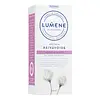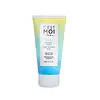What's inside
What's inside
 Key Ingredients
Key Ingredients

 Benefits
Benefits

 Concerns
Concerns

 Ingredients Side-by-side
Ingredients Side-by-side

Water
Skin ConditioningOctyldodecyl Myristate
EmollientBetaine
HumectantGlycerin
HumectantPropanediol
SolventArachidyl Alcohol
EmollientButyrospermum Parkii Butter
Skin ConditioningPrunus Amygdalus Dulcis Oil
Skin ConditioningHydrogenated Palm Kernel Glycerides
EmollientCetearyl Alcohol
EmollientBehenyl Alcohol
EmollientEriophorum Spissum Flower/Stem Extract
Skin ConditioningPhenoxyethanol
PreservativeArachidyl Glucoside
EmulsifyingDimethicone
EmollientCetearyl Glucoside
EmulsifyingSodium Polyacrylate
AbsorbentHydrogenated Palm Glycerides
EmollientEthylhexylglycerin
Skin ConditioningAllantoin
Skin ConditioningPEG-8
HumectantTocopherol
AntioxidantPotassium Sorbate
PreservativeAscorbyl Palmitate
AntioxidantSorbic Acid
PreservativeAscorbic Acid
AntioxidantCitric Acid
BufferingBenzyl Salicylate
PerfumingCitronellol
PerfumingLimonene
PerfumingParfum
MaskingWater, Octyldodecyl Myristate, Betaine, Glycerin, Propanediol, Arachidyl Alcohol, Butyrospermum Parkii Butter, Prunus Amygdalus Dulcis Oil, Hydrogenated Palm Kernel Glycerides, Cetearyl Alcohol, Behenyl Alcohol, Eriophorum Spissum Flower/Stem Extract, Phenoxyethanol, Arachidyl Glucoside, Dimethicone, Cetearyl Glucoside, Sodium Polyacrylate, Hydrogenated Palm Glycerides, Ethylhexylglycerin, Allantoin, PEG-8, Tocopherol, Potassium Sorbate, Ascorbyl Palmitate, Sorbic Acid, Ascorbic Acid, Citric Acid, Benzyl Salicylate, Citronellol, Limonene, Parfum
Water
Skin ConditioningGlycerin
HumectantPrunus Amygdalus Dulcis Oil
Skin ConditioningCetearyl Alcohol
EmollientButyrospermum Parkii Butter
Skin ConditioningLeuconostoc/Radish Root Ferment Filtrate
AntimicrobialPropanediol
SolventCera Alba
EmollientRosa Centifolia Flower Water
Skin ConditioningCetearyl Glucoside
EmulsifyingCetyl Palmitate
EmollientAloe Barbadensis Leaf Juice
Skin ConditioningXanthan Gum
EmulsifyingSodium Phytate
Helianthus Annuus Seed Oil
EmollientOryza Sativa Extract
AbsorbentTocopherol
AntioxidantActinidia Chinensis Fruit Extract
EmollientOctyldodecyl Myristate
EmollientFragaria Vesca Fruit Extract
AstringentCalendula Officinalis Flower Extract
MaskingZea Mays Starch
AbsorbentPyrus Malus Fruit Extract
Skin ConditioningSodium Benzoate
MaskingPotassium Sorbate
PreservativeCitric Acid
BufferingSodium Levulinate
Skin ConditioningWater, Glycerin, Prunus Amygdalus Dulcis Oil, Cetearyl Alcohol, Butyrospermum Parkii Butter, Leuconostoc/Radish Root Ferment Filtrate, Propanediol, Cera Alba, Rosa Centifolia Flower Water, Cetearyl Glucoside, Cetyl Palmitate, Aloe Barbadensis Leaf Juice, Xanthan Gum, Sodium Phytate, Helianthus Annuus Seed Oil, Oryza Sativa Extract, Tocopherol, Actinidia Chinensis Fruit Extract, Octyldodecyl Myristate, Fragaria Vesca Fruit Extract, Calendula Officinalis Flower Extract, Zea Mays Starch, Pyrus Malus Fruit Extract, Sodium Benzoate, Potassium Sorbate, Citric Acid, Sodium Levulinate
Ingredients Explained
These ingredients are found in both products.
Ingredients higher up in an ingredient list are typically present in a larger amount.
This ingredient is also known as shea butter. It is an effective skin hydrator and emollient.
Emollients help soothe and soften your skin. It does this by creating a protective film on your skin. This barrier helps trap moisture and keeps your skin hydrated. Emollients may be effective at treating dry or itchy skin.
Shea butter is rich in antioxidants. Antioxidants help fight free-radicals, or molecules that may harm the body. It is also full of fatty acids including stearic acid and linoleic acid. These acids help replenish the skin and keep skin moisturized.
While Shea Butter has an SPF rating of about 3-4, it is not a sunscreen replacement.
Shea butter may not be fungal acne safe. We recommend speaking with a professional if you have any concerns.
Learn more about Butyrospermum Parkii ButterCetearyl alcohol is a mixture of two fatty alcohols: cetyl alcohol and stearyl alcohol. It is mainly used as an emulsifier. Emulsifiers help prevent the separation of oils and products. Due to its composition, it can also be used to thicken a product or help create foam.
Cetearyl alcohol is an emollient. Emollients help soothe and hydrate the skin by trapping moisture.
Studies show Cetearyl alcohol is non-toxic and non-irritating. The FDA allows products labeled "alcohol-free" to have fatty alcohols.
This ingredient is usually derived from plant oils such as palm, vegetable, or coconut oils. There is debate on whether this ingredient will cause acne.
Due to the fatty acid base, this ingredient may not be Malassezia folliculitis safe.
Learn more about Cetearyl AlcoholCetearyl Glucoside is a surfactant and emulsifier. It can be produced from synthetic of natural sources of cetearyl alcohol and glucose.
Emulsifiers help prevent ingredients from separating, such as oils and waters. It can also be used to enhance the texture of products.
As a surfactant, Cetearyl Glucoside helps during the cleansing process. By gathering all the dirt and oils, it allows these molecules to be washed away easily.
Learn more about Cetearyl GlucosideCitric Acid is an alpha hydroxy acid (AHA) naturally found in citrus fruits like oranges, lemons, and limes.
Like other AHAs, citric acid can exfoliate skin by breaking down the bonds that hold dead skin cells together. This helps reveal smoother and brighter skin underneath.
However, this exfoliating effect only happens at high concentrations (20%) which can be hard to find in cosmetic products.
Due to this, citric acid is usually included in small amounts as a pH adjuster. This helps keep products slightly more acidic and compatible with skin's natural pH.
In skincare formulas, citric acid can:
While it can provide some skin benefits, research shows lactic acid and glycolic acid are generally more effective and less irritating exfoliants.
Most citric acid used in skincare today is made by fermenting sugars (usually from molasses). This synthetic version is identical to the natural citrus form but easier to stabilize and use in formulations.
Read more about some other popular AHA's here:
Learn more about Citric AcidGlycerin is already naturally found in your skin. It helps moisturize and protect your skin.
A study from 2016 found glycerin to be more effective as a humectant than AHAs and hyaluronic acid.
As a humectant, it helps the skin stay hydrated by pulling moisture to your skin. The low molecular weight of glycerin allows it to pull moisture into the deeper layers of your skin.
Hydrated skin improves your skin barrier; Your skin barrier helps protect against irritants and bacteria.
Glycerin has also been found to have antimicrobial and antiviral properties. Due to these properties, glycerin is often used in wound and burn treatments.
In cosmetics, glycerin is usually derived from plants such as soybean or palm. However, it can also be sourced from animals, such as tallow or animal fat.
This ingredient is organic, colorless, odorless, and non-toxic.
Glycerin is the name for this ingredient in American English. British English uses Glycerol/Glycerine.
Learn more about GlycerinWe don't have a description for Octyldodecyl Myristate yet.
Potassium Sorbate is a preservative used to prevent yeast and mold in products. It is commonly found in both cosmetic and food products.
This ingredient comes from potassium salt derived from sorbic acid. Sorbic acid is a natural antibiotic and effective against fungus.
Both potassium sorbate and sorbic acid can be found in baked goods, cheeses, dried meats, dried fruit, ice cream, pickles, wine, yogurt, and more.
You'll often find this ingredient used with other preservatives.
Learn more about Potassium SorbatePropanediol is an all-star ingredient. It softens, hydrates, and smooths the skin.
It’s often used to:
Propanediol is not likely to cause sensitivity and considered safe to use. It is derived from corn or petroleum with a clear color and no scent.
Learn more about PropanediolPrunus Amygdalus Dulcis Oil comes from the sweet almond, a tree native to Iran. This oil has no fragrance and is non-volatile.
Almonds contain healthy fats, vitamins, and minerals. It is a rich source of Vitamin E, a great antioxidant and skin conditioning ingredient. Sweet almond oil contains fatty acids such as linolenic acid and triglycerides.
The content of sweet almond oil makes it a great emollient; it can help soften and hydrate your skin. Emollients create a barrier over your skin to trap moisture in. Sweet almond oil has antioxidant properties.
Those with an almond allergy should be careful of this ingredient and speak with a professional about using it in your skincare.
This ingredient may not be fungal-acne safe.
Learn more about Prunus Amygdalus Dulcis OilTocopherol (also known as Vitamin E) is a common antioxidant used to help protect the skin from free-radicals and strengthen the skin barrier. It's also fat soluble - this means our skin is great at absorbing it.
Vitamin E also helps keep your natural skin lipids healthy. Your lipid skin barrier naturally consists of lipids, ceramides, and fatty acids. Vitamin E offers extra protection for your skin’s lipid barrier, keeping your skin healthy and nourished.
Another benefit is a bit of UV protection. Vitamin E helps reduce the damage caused by UVB rays. (It should not replace your sunscreen). Combining it with Vitamin C can decrease sunburned cells and hyperpigmentation after UV exposure.
You might have noticed Vitamin E + C often paired together. This is because it is great at stabilizing Vitamin C. Using the two together helps increase the effectiveness of both ingredients.
There are often claims that Vitamin E can reduce/prevent scarring, but these claims haven't been confirmed by scientific research.
Learn more about TocopherolWater. It's the most common cosmetic ingredient of all. You'll usually see it at the top of ingredient lists, meaning that it makes up the largest part of the product.
So why is it so popular? Water most often acts as a solvent - this means that it helps dissolve other ingredients into the formulation.
You'll also recognize water as that liquid we all need to stay alive. If you see this, drink a glass of water. Stay hydrated!
Learn more about Water